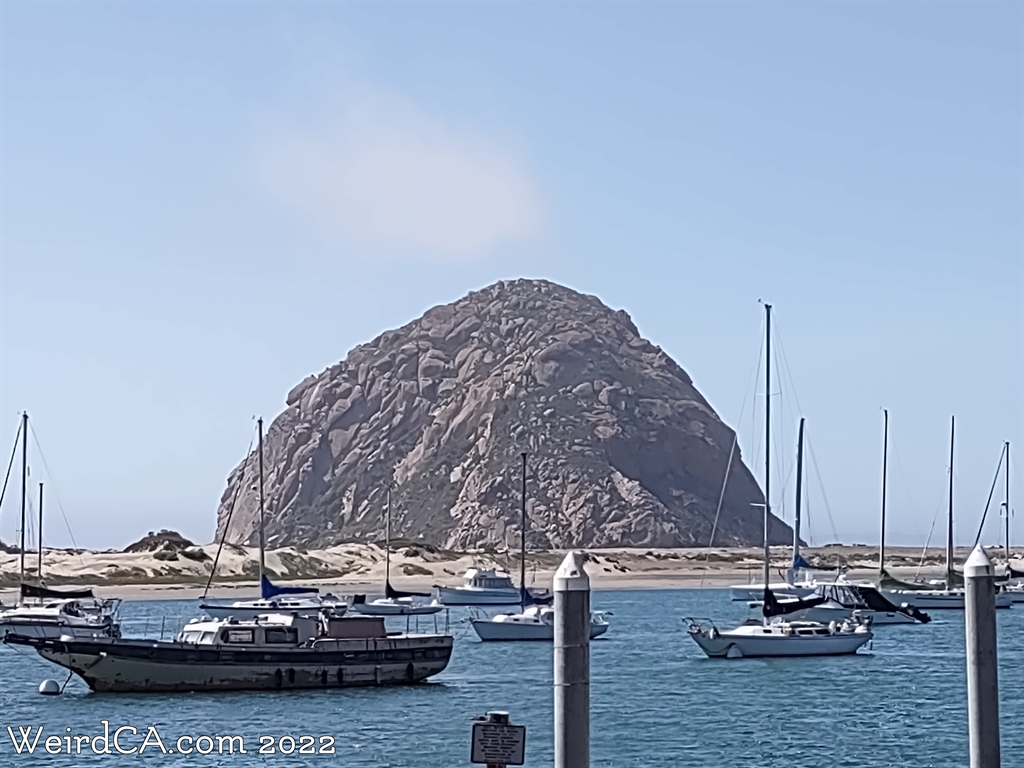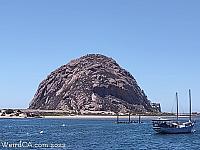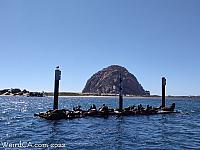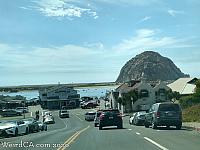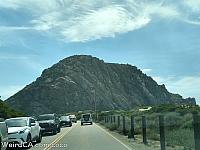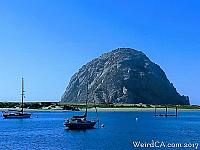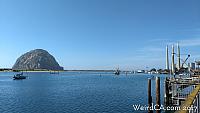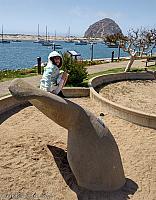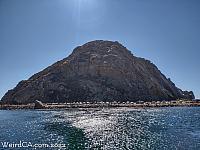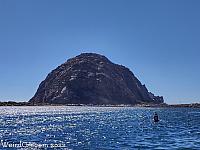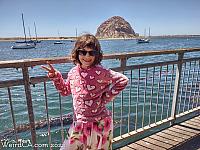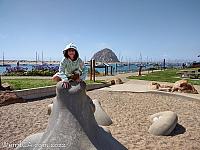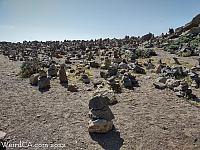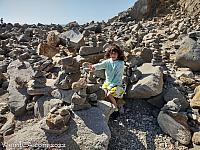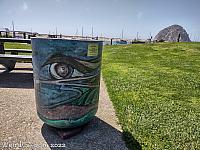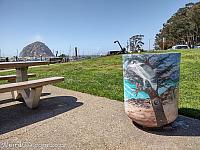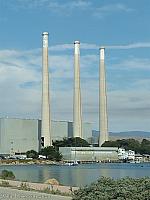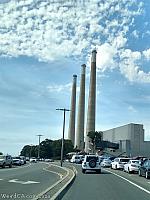Morro Rock
 Coleman Drive,
Morro Bay, California
93442
Coleman Drive,
Morro Bay, California
93442
Driving down Route 1, also called the Pacific Coast Highway, you've left San Luis Obispo and the ocean is coming back into view as you approach Morro Bay, and there it is, rising up in the distance, looming over the countryside, a huge gigantic rock jutting out on the coastline, sitting on the edge of the ocean!
This is the Morro Rock, a volcanic plug, that sits at the entrance to the Morro Bay harbor and it rises up 581 feet over the coastline. It connects to the land and you can reach it easily by driving down the Embarcadero of the small beach town. This former volcano probably went dormant some 23 million years ago, and is part of the chain of sisters, often called the "Nine Sisters" or the "Seven Sisters", a group of various peaks that run from San Luis Obispo and end with the Morro Rock. They are usually referred to as nine or seven, despite there being way more, because nine or seven simply sounds better. Islay Peak in San Luis Obispo is the first one, and if you wish you can hike up it to find a cool fiberglass cow sculpture at the top. Other more popular peaks that are part of the chain include Bishop's Peak in San Luis Obispo and Black Hill in Morro State Park. Both of those are also hikable.
Morro Rock, on the other hand is neither hikable nor climbable with one exception. Both the Salinan and Chumash Native American tribes consider the rock to be sacred. The Salinan tribe has been granted the right to climb the rock in twice a year solstice ceremonies. According to their legend a hawk and a raven teamed up to destroy the two headed serpent monster, Taliyekatapelta, who had wrapped its body around the base of the rock. The Chumash, however, believe that the rock should never be climbed and dispute the Salinan's claim to the Morro Rock as territory. The general public is not allowed to climb the rock. The act is not only illegal, but people have and will be arrested and cited if they do so. In addition to the cultural significance, the rock is also off limits due to being a reserve for peregrine falcons and also acting as a nesting area for snowy plovers. The birds have certainly added to the rock over the years, as after the main component, dacite, which is an igneous volcanic rock, much of the Rock's composition is, not surprisingly, bird feces, which have dried and compacted onto the rock over the centuries.
Before Morro Rock was declared California Historical Landmark #821 in February 1968, it was quarried for a while from 1889 until 1969. It ended up supplying material both for the breakwater in Morro Bay, as well as material used to form Port San Luis. It is estimated that possibly up to a million tons of rock was taken, mostly on the south and east sides of Morro Rock. Chumash Native Americans have been attempting to restore these missing rocks, and in the second half of 2022, the U.S. Army Corps of Engineers transported rocks from Port San Luis back to Morro Rock. They laid them underwater west of Morro Rock, where the rocks will become a new habitat for various ocean creatures.
In addition to the aforementioned birds, sea otters live right near the rock, frolicking in the nearby kelp. Sea lions and seals can also be found in the waters around the rock. Additionally, a few different whale species migrate past Morro Rock.
Despite the significance that Morro Rock has to Native Americans, its name originates from Europeans. Morro means "crown-shaped hill" in Spanish. The most likely first Europeans to see the rock were from a Spanish expedition, possibly under Juan Rodriguez Cabrillo, probably around 1542 upon his ship the San Salvador. Morro Rock has often played an important part as a navigational aid for seafaring ships. However, despite this, it probably wasn't actually named until a Spanish land expedition came through the area in 1769, camping in the area on September 8th. An expedition member noted in his journal that they "saw a great rock in the form of a round morro". Although I have heard conflicting reports stating that Juan Cabrillo did, in fact, name the rock all the way back in 1542 supposedly, calling it El Moro, apparently after the style of hat worn by the Moors of Spain. The town of Morro Bay was founded in 1870, obviously named after the rock.
Morro Rock is rather easy to get to. When you arrive at the embarcadero, the coastal street with several shops, restaurants, and other attractions, you turn right, and drive down Embarcadero through Morro Bay heading towards the rock. Eventually, Embarcadero will veer to the right, shortly after the closed power plant aka The Three Stacks. Instead of veering to the right, you remain on the road, basically heading left, and will now be on Coleman Drive about to reach the rock. Soon after heading down Coleman, parking for Morro Rock Beach will appear on the right. More parking will come up, on both sides of the road. To the left will be the closest on the land that you can get to a popular sea otter viewing location. The road will end in a gate, and you will have to proceed on foot. The rock will rise up to your right as you walk out towards the ocean. The road ends in piles and piles of rocks, rocks that eventually head south into the water to form a breakwater. Over the past few years, people have stacked hoards of the smaller rocks into numerous towers, creating a little mini rock forest.
Three Stacks and a Rock. About a half mile from the Rock, sits an old defunct power plant with three 450 foot tall concrete smokestacks. The power plant was shut down in 2014, and was built by PG&E back in the early fifties. Duke Energy owned the plant and stacks in 1998. The three stacks have been there for decades and have become iconic to the area. However, that will change a few years from now. The power plant is now owned by Vistra Corp, who plans to build the largest battery storage facility in the world. Since, it was cost prohibitive for the city of Morro Bay to maintain the three stacks, they have been ceded to Vistra, who has agreed to tear down the stacks by the end of 2027. In the meanwhile, for about the next half decade, visitors can still enjoy (or detest) the towering stacks that rise up to the right of the rock.
A visit to Morro Bay is extremely refreshing and relaxing. Visitors should absolutely visit the Rock, walk up and down the Embarcadero, shop in the stores along it, and enjoy the various water activities available in town. Several boat tours depart the Embarcadero including shorter bay tours as well as longer whale watching expeditions.
Follow WeirdNV.com!
Closest Weird
Crab Pot Christmas Tree
(Morro Bay T Pier)
0.63 Miles Away
Morro Bay, California
Giant Chess Set
0.84 Miles Away
Morro Bay, California
Sinclair Dinosaurs
1.51 Miles Away
Morro Bay, California
First Created: 2022-09-11
Last Edited: 2022-09-11



